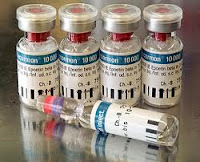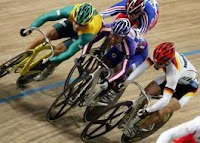Eight Weeks on Moderate Doses of Erythropoietin (EPO) Build a Bigger Mitochondrial Engine and Shed Some Body Fat, but is That Really Worth Taking the Risk?
 |
| Image 1: These EPO containing Recormon vials are highly popular in the French Pyrenees ;-) |
More red blood cells transport more oxygen to larger mitochondria
About two years ago, a group of researchers from the Duke University Medical Center discovered that the "blood-building" drug Erythropoietin had an unexpected yet not exactly undesirable side-effect: It activated cardiac mitochondrial biogenesis - or, to stick to the previously introduced "terminology" it tuned the lab rats engines (Carraway. 2010). Now, in the latest issue of Frontiers in Physiology a group of European researchers reproduced these results in a group of six healthy young men (21 ± 2 years, 180 ± 1 cm, weight 73± 2 kg) who participated voluntarily (no, the study does not state that those were Tour de France competitors ;-) in an 8-week trial. Over the course of the study period received an additional iron supplement (100mg; was in fact started 2 weeks prior) which, obviously in conjunction with the EPO treatment,
- 1st week: daily subcutaneous injections of 5,000IU of rhEPO
- 2nd-7th week: weekly subcutaneous injections of either 0, 2500, or 5000 IU, depending on the subjects' Hct level
After the 8 week intervention period, the mean Hct for the whole group was increased significantly to 51 ± 1%. Three of the six subjects received full treatment dosage with a total of 70.000 IU rhEpo over 8 weeks, while two subjects were administered 67.500 and 62.500 IU, respectively. The remaining subject exhibited a strong response to the rhEpo injections, and received a total of 50.000 IU.The maximal oxygen consumption of the study participants, which was measured during a standardized exercise protocol (+35W increase in resistance every 60s) on a braked cycle ergometer, increased regardless of the dosage that was required to keep the hematocrit values from 54 to 58ml/kg per minute (cf. figure 1).
 |
| Figure 1: Changes in body composition and measures of oxidative capacity in the course of the 8-week treatment period (data calculated based on Plenge. 2012) |
"Cool, bro! Where can I get this EPO?"
 |
| Image 2: You better take their bikes than their drugs. |
After all, the overweight women in the Trilk study achieved a +12% increase in VO2Max after no more than 12 HIIT sessions consisting of 4-7 30s all-out sprints on an cycle ergometer, which were seperated by four minutes rest. And let's be honest, if you'd rather take a highly expensive, potentially dangerous drug from the gray market than invest ~90min of your precious weekly TV time into some HIIT exercise, you should not wonder if you are sick and obese.


